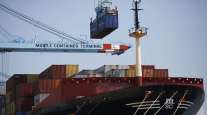Intermodal Freight Hits Record High in 2012, Powered by Domestic Containers, IANA Says
This story appears in the Feb. 18 print edition of Transport Topics.
Intermodal freight in North America set an all-time record of 14.6 million shipments in 2012, powered by continued growth in domestic container shipments during the fourth quarter, the Intermodal Association of North America announced.
The results topped the previous record of 14.2 million set in 2006.
For the year, IANA reported international container shipments rose 1.7% to 7.58 million, and domestic intermodal shipments rose 6.5% to 7.05 million.
The domestic intermodal total reflected a 12% rise in shipments moved in containers but a 10% drop in trailer shipments as customers continued to shift freight from that equipment to containers.
IANA’s report, issued Feb. 7, includes intermodal freight carried by Canadian National Railway and Canadian Pacific Railway, which together increased about 7%. U.S. railroads just missed setting a record for truck-rail moves in the country, the Association of American Railroads reported last month.
Another record year is expected in 2013, according to IANA.
“2013 is going to reprise 2012 for most of the freight categories,” Joni Casey, president of IANA, told Transport Topics on Feb. 8. “We are looking at domestic containers that could be up as much as 10%.”
Domestic truck-rail freight gained 4.9% in the fourth quarter to 1.82 million loads. Continuing the pattern seen throughout the rest of the year, domestic container shipments rose in the fourth quarter, while trailer shipments continued to sag.
“There is no reason to think that trend is going to end,” she said. “All of the same factors are at play — the service capacity of intermodal, the increasing investments by the railroads in intermodal and the constraints in the trucking industry, such as drivers and fuel.”
None of those factors look like they are going to change in the next six or eight months, she added. “One of the issues to watch later this year is hours of service.”
Intermodal also could gain, Casey said, if the hours-of-service rule changes planned by the Federal Motor Carrier Safety Administration take effect this summer, resulting in reduced capacity for trucking fleets. American Trucking Associations has asked for a delay in those while its court challenge continues.
She also cited another potential positive for intermodal — diesel prices have risen sharply in recent weeks. “Any time there is a 15% or 20% increase in fuel, it’s followed by an increase in intermodal loadings,” Casey said.
On the international side, Casey expects container loads to increase between 2% and 4% over 2012 levels. She said IANA was “marginally surprised” by fourth-quarter results in international container freight, saying a “more significant pullback” was expected in the period.
International loads fell 0.7% to 1.86 million in the quarter. Because of labor disruptions, the group’s report didn’t tie the drop directly to Superstorm Sandy and uncertainty about international cargo. “It would be easy to dismiss international’s performance as symptomatic of a couple of extraordinary events,” the report said. “These factors seem to have had a relatively small effect.”
The report noted that East Coast intermodal freight grew in October and November despite Sandy. However, December international volume fell 10%, and was at the lowest level since 2009, the report said.




